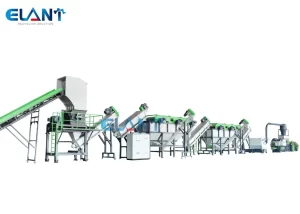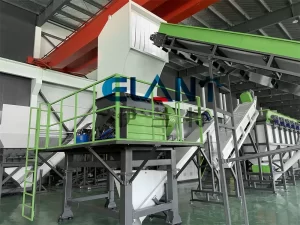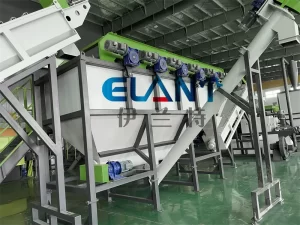Plastic waste is one of the world’s most challenging environmental issues. Within the realm of plastic recycling, the PP PE film washing line process has emerged as a crucial step in transforming waste material into reusable resources. This process not only enables sustainable practices but also ensures that recyclable films—mainly polypropylene (PP) and polyethylene (PE)—are converted into high-quality materials suitable for various applications.
Introduction to PP and PE Film Recycling
Polypropylene (PP) and polyethylene (PE) films are widely used plastics found in various consumer and industrial products, such as packaging films, agricultural films, and protective coverings. Despite their value, these films often become waste due to poor recycling rates and improper disposal. The PP PE film washing line is designed to handle the high contamination of these films and transform them into clean, reusable materials, paving the way for sustainable recycling and reduced environmental impact.
What is a PP PE Film Washing Line?
A PP PE film washing line is a sophisticated recycling setup that comprises multiple stages, each aimed at eliminating contaminants, breaking down the material, and preparing it for reuse. This washing line is essential in recycling because PP and PE films often carry contaminants like dirt, oils, labels, and adhesives, making traditional recycling methods ineffective. The washing line addresses these challenges by incorporating specialized equipment that can handle various impurities, resulting in a cleaner final product.

The Stages of the PP PE Film Washing Line Process
Each step in the PP PE film washing line plays a unique role in achieving a thoroughly cleaned material ready for reprocessing. Here’s an in-depth look at each stage.
Pre-Cutting and Shredding
The first stage involves pre-cutting and shredding the plastic film into manageable sizes. Large film pieces, whether from agricultural use or industrial packaging, are often too cumbersome to process directly. Shredders and cutters reduce the film into smaller fragments, allowing for easier handling and increased efficiency in subsequent stages.
Pre-Washing
The pre-washing stage removes surface dirt and initial impurities, such as soil, sand, and other physical debris that may adhere to the plastic film. Large washers, often equipped with paddle scrapers, agitate the material in water, loosening contaminants from the surface. Pre-washing is essential because it reduces the burden on later steps and ensures that the most significant impurities are eliminated early in the process.
High-Speed Friction Washing
Friction washing is a more intensive cleaning phase, where the shredded film is rapidly agitated by high-speed rotors. This phase targets smaller contaminants like oil, grease, and residual adhesives, ensuring that even stubborn impurities are removed. The rotor’s high speed creates a powerful scrubbing action, making it highly effective for cleaning PP and PE films.
Hot Washing and Detergent Application
To further purify the plastic film, it undergoes a hot wash where heated water, often combined with a detergent, breaks down remaining contaminants. The heated environment enhances the effectiveness of detergents in removing oils, adhesives, and other sticky substances. This stage is especially critical for PE and PP films used in industrial applications, as they are more likely to contain persistent, complex contaminants.
Separation and Rinsing
After the hot wash, the material is rinsed thoroughly to eliminate any remaining detergent and impurities. A separation tank is often used here, allowing clean plastic fragments to float while heavier contaminants sink to the bottom, effectively isolating the plastic film from any remaining debris. This separation process helps increase the purity level of the material, making it suitable for high-grade applications.

Key Machinery in the PP PE Film Washing Line
The efficiency of a PP PE film washing line relies heavily on the machinery used. Here are the main components typically involved:
Shredders and Granulators: Break down the film into smaller pieces for easier washing and sorting.
Friction Washers: Use high-speed rotors to scrub contaminants off the plastic surface.
Hot Wash Tanks: Heat and detergent are applied to loosen persistent contaminants.
Separation Tanks: Ensure only clean plastic material advances, while heavier waste settles at the bottom.
Dewatering Machines: These machines extract excess water, reducing drying time and energy consumption.
Dryers: Hot air dryers or centrifugal dryers prepare the material for reprocessing by removing remaining moisture.
Each piece of machinery is designed to work in tandem with others, maximizing cleaning efficiency and ensuring a high-quality end product.
Final Steps: Drying and Quality Control
Once cleaned, the plastic film enters the final stages: dewatering and drying. Dewatering machines remove excess water by centrifugal force or pressing, while dryers remove remaining moisture. High-quality drying ensures that the material is in optimal condition for storage or further processing, preventing issues such as mold or bacterial growth.
After drying, the material undergoes quality control checks to confirm cleanliness and suitability for reprocessing. Quality checks include assessing the purity level and ensuring the removal of unwanted residues. These final steps are crucial in producing a product that meets industry standards and consumer demands.
Benefits of Using a PP PE Film Washing Line
Environmental Impact
The PP PE film washing line offers a substantial environmental benefit by recycling waste plastic that might otherwise end up in landfills or the natural environment. By converting waste into reusable materials, these washing lines support a circular economy, reducing reliance on virgin plastics and conserving natural resources.
Cost-Effectiveness for Recycling Facilities
While initial investment in a PP PE film washing line may be high, the long-term benefits often outweigh the costs. Efficient cleaning and preparation of recycled plastics reduce the need for expensive raw materials and allow facilities to produce a consistent quality of material for resale. Additionally, a well-maintained washing line has a high processing capacity, which can lead to significant cost savings over time.
High-Quality Recycled Output
A clean, uncontaminated final product increases the usability of recycled PP and PE films. The high purity of the output material makes it suitable for various applications, from packaging to automotive components, ensuring that recycling efforts yield valuable, versatile resources.

Challenges and Solutions in the PP PE Film Washing Process
Contamination Levels and Sorting
One of the biggest challenges in the PP PE film washing process is managing high contamination levels. Films can be laden with various contaminants, from agricultural residue to industrial oils. Effective pre-sorting and proper handling techniques can mitigate these challenges, as can investing in high-quality equipment specifically designed for dealing with heavy contamination.
Water and Energy Consumption
The washing process consumes considerable water and energy, raising concerns about resource efficiency. Many facilities address these issues by implementing closed-loop water systems, which recycle and reuse water, and energy-efficient machinery to keep consumption under control. Investing in advanced, energy-efficient equipment is another way to ensure a balance between effectiveness and sustainability.
The Role of PP PE Film Washing Lines in Sustainable Recycling
The PP PE film washing line represents a vital step in modern plastic recycling efforts. By transforming contaminated waste film into clean, reusable material, this process supports a sustainable approach to managing plastic waste. From pre-washing and friction cleaning to hot washing and drying, each step contributes to a system that is not only efficient but also environmentally beneficial. As recycling technologies evolve, the importance of robust, efficient washing lines will only continue to grow, making them a cornerstone of the recycling industry and a crucial element in the global push toward a circular economy.
